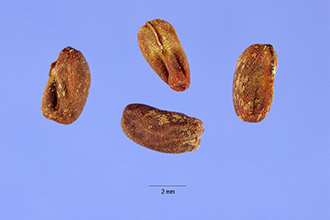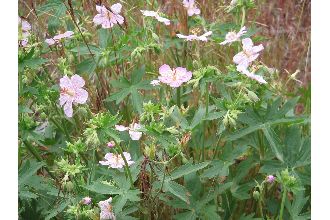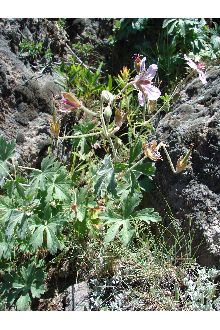Sticky Purple Geranium
Scientific Name: Geranium viscosissimum Fisch. & C.A. Mey. ex C.A. Mey.

| General Information | |
|---|---|
| Usda Symbol | GEVI2 |
| Group | Dicot |
| Life Cycle | AnnualPerennial, |
| Growth Habits | Forb/herb |
| Native Locations | GEVI2 |
Plant Guide
Alternate Names
Sticky geranium, pink geranium, cranesbillThis species should not be confused with Geranium richardsonii Fisch. & Trautv., which is also sometimes referred to as sticky geranium. G. richardsonii has pale pink to white flowers, and has leaves with hairs only along the veins on the lower sides, whereas leaves of G. viscosissium, and are sticky-hairy all over. Other common names for G. richardsonii include Richardson’s geranium and white geranium. There are reports of possible hybridization between the two species (Parish et al 1996).
Uses
Ornamental: Sticky purple geranium is an excellent choice for sustainable urban landscapes because it needs little supplemental irrigation, it blooms continuously May through August, and the foliage turns red in the fall (Mee et al 2003). The plant grows well in areas receiving full sun or partial shade. It can spread if it receives too much shade or water. Ethnobotanical: The roots and leaves of sticky purple geranium were used by the Blackfeet, Okanagan, Colville, Sanpoil, Nlaka’pmx and other Native American tribes. Medicinal uses included a cold remedy, a dermatological aid, and treatment for sore eyes. It was also used to make a love potion and as a food preservative (Native American Ethnobotany Database 2010; Parish et al 1996). Herbalists apply it to cuts to help blood clotting or use it internally to stop bleeding (Parish et al 1996). Wildlife: Seeds of this plant are eaten by birds and small mammals (Mee et al 2003) and leaves are foraged by small mammals, deer, elk and bears (Robson and Kingery 2006). Pollinator habitat: Sticky purple geranium is pollinated by flies, butterflies and native bees (Mee et al 2003). Finer (2003) found within the Palouse ecoregion of eastern Washington, seed set of sticky purple geranium declined with reduced habitat size, as did pollinator visitation, richness and diversity.
Status
Consult the PLANTS Web site and your State Department of Natural Resources for this plant’s current status (e.g., threatened or endangered species, state noxious status, and wetland indicator values).
Description
General: Rose Family (Rosaceae). Sticky purple geranium is a native perennial forb that grows to 40 to 90 cm tall. It has sticky glandular hairs that densely cover the stems and leaves. Leaves are basal, on long stalks and have blades 5 to 12 cm wide. The leaves are deeply palmately lobed into 5 to 7 sharply toothed divisions. Flowers are 2.5 cm wide, occur in open clusters near the top, and have 5 petals. Petals are pinkish-lavender to deep purple-magenta with purple veins and soft hairs on the lower half. Seed capsules are elongated, glandular and hairy, with a long beak shaped like a stork’s or crane’s bill. The genus Geranium is derived from the Greek word geranos, which means crane (Parish et al 1996). Sticky purple geranium has an interesting feature of being protocarnivorous; it is able to dissolve protein, such as insects, that become trapped on its leaf surface and absorb the nitrogen derived from the protein (Spomer 1999). Many plants with sticky leaf surfaces have evolved to have this characteristic in order to thrive in nutrient-poor environments (Larcher 2003). Pamela Scheinost, Pullman Plant Materials Center Sticky purple geranium has an interesting feature of being protocarnivorous; it is able to dissolve protein, such as insects, that become trapped on its leaf surface and absorb the nitrogen derived from the protein (Spomer 1999). Many plants with sticky leaf surfaces have evolved to have this characteristic in order to thrive in nutrient-poor environments (Larcher 2003). Distribution: This plant is widely distributed and locally abundant throughout its range (Parrish et al 1996). It is found from southern British Columbia south through eastern Washington and Oregon to northern California, and east to northwestern New Mexico, western Colorado and Saskatchewan. There are two ecotypes: Geranium viscosissimum var. incisum, which is found within the entire range of the species, and Geranium viscosissimum var. viscosissimum, which does not extend into Colorado, Utah or New Mexico. For current distribution, consult the Plant Profile page for this species on the PLANTS Web site. Habitat: Sticky purple geranium is found in foothills, canyons, open woodlands to montane environments. It is often associated with subalpine, coniferous forest, aspen forest, meadow, mountain brush and shrub steppe plant communities (Mee et al 2003).
Adaptation
Sticky purple geranium grows in areas receiving 25 to 50 or more centimeters (10 to 20 or more inches) of annual precipitation at elevations ranging from 300 to 3,200 meters (1,000 to 10,500 feet). It is hardy to Zone 2 (Mee et al 2003). It is commonly found on well-drained soil, however it can grow on a variety of soil types (Robson and Kingery 2006).
Establishment
Germination of sticky purple geranium is improved with a combination of seed treatments. Luna and Lapp (2008) achieved 50 – 84% germination by scarifying seed with a hot water bath for 5 – 10 seconds and immediately transferring to a cold water bath, where they left the seeds soak for 24 hours. Robson and Kingery (2006) recommend scarifying seed with fine-grit sand paper prior to soaking in cold water for 24 hours. Treated seed should be drilled in the fall at a depth of ¼ inch into a firm, weed free seed bed at a rate of 1.6 kilograms Pure Live Seed (PLS) per hectare (1.4 pounds per acre) for pure stands (Lambert 2005). When seeded in a mix, the seed rate should be adjusted according to the proportion of the mix. Germination may be sporadic and establishment may take up to 3 years (Robson and Kingery 2006). More rapid establishment can be achieved by transplanting seedlings. With this method, treated seed should be sown into containers and then cold-moist stratified for at least 30 days prior to being transferred to a greenhouse. Seedlings can be transplanted to the desired sites in the spring or fall.
Management
Sticky purple geranium requires low to moderate fertility. Many new plants can result from seed shatter in subsequent years. To prevent unwanted plants, remove the seedpods before they are fully ripe. Plants become woody with age and should be separated.
Pests and Potential Problems
Some native and cultivated stands of sticky purple geranium are susceptible to powdery mildew, which can be controlled with fungicidal sprays (Jensen 2010).
Environmental Concerns
Concerns
Concerns
None
Seeds and Plant Production
Plant Production , Use soil moisture sensors to measure the soil moisture of Sticky Purple Geranium.
Plant Production
Seed pods mature indeterminately and shatter easily (Skinner 2008). The pods should be collected in mid-August before the capsules split, placed into paper bags, transferred to mesh bags and allowed to dry (Robson and Kingery 2006; Luna and Lapp 2008). Seeds are grey to brown when mature and can be cleaned with a hammer mill and office clipper (Luna and Lapp 2008). There are about 121,000 seeds per kilogram (55,000 seeds per pound) (Skinner 2008). Seed is commercially available through several vendors. Cultivars, Improved, and Selected Materials (and area of origin) None
References
Finer, M. 2003. Effects of geitonogamy, habitat fragmentation, and population size on plant reproductive success: ecological and evolutionary studies. Ph.D. diss. Washington State Univ., Pullman, WA. Jensen, J. 2010. Personal communication. Thorn Creek Native Seeds, Genesee, ID. Lambert, S. 2005. Guidebook to the Seeds of Native and Non-Native Grasses, Forbs and Shrubs of the Great Basin. Idaho BLM Technical Bulletin 2005-04. United States Department of the Interior, Bureau of Land Management, Boise, ID. Larcher, W. 2003. Physiological Plant Ecology, 4 th Luna, T. and J. Lapp. 2008. Propagation protocol for production of container Geranium viscosissimum Fisch. & Mey ex. Mey; United States Department of the Interior, National Park Service, Glacier National Park, West Glacier, Montana. In: Native Plant Network. [Online] Available at http://www.nativeplantnetwork.org (accessed 10 June 2010). University of Idaho, College of Natural Resources, Forest Research Nursery, Moscow, ID. ed. Springer-Verlag, Berlin and Heidelberg. Mee, W., J. Barnes, R. Kjelgren, R. Sutton, T. Cerny, C. Johnson. 2003. Waterwise: Native Plants for Intermountain Landscapes. Utah State University Press, Logan, UT. Native American Ethnobotany Database. 2010. [Online] Available at http://herb.umd.umich.edu/ (Accessed 6 June 2010). University of Michigan, Dearborn, MI. Parish, R., R. Coupe, D. Lloyd (eds). 1996. Plants of Southern Interior British Columbia and the Inland Northwest. Lone Pine Publishing, Vancouver, BC. Robson, S. and J. Kingery. 2006. Native Plants for Roadside Restoration and Revegetation Programs. [Online] Available at http://www.itd.idaho.gov/manuals/Online_ManuMan /Current_Manuals/Roadside_Revegetation/RoRoadsi _Revegetation.pdf (Accessed 6 June 2010) University of Idaho, Moscow, ID. Skinner, D. 2008. Unpublished data. USDA NRCS Plant Materials Center, Pullman, WA. Spomer, G. 1999. Evidence of protocarnivorous capabilities in Geranium viscosissimum and Potentilla arguta and other sticky plants. Int. J. Plant Sci. 160:98-101.
Prepared By
Pamela L. Scheinost, USDA NRCS Plant Materials Center, Pullman, Washington Mark E. Stannard, USDA NRCS Plant Materials Center, Pullman, Washington Citation Scheinost, P.L. and M.E. Stannard. 2010. Plant guide for sticky purple geranium (Geranium viscosissimum). USDA-Natural Resources Conservation Service, Plant Materials Center. Pullman, WA. Published July, 2010 Edited: 11June2010mes; 11June2010jab; 29June2010pls For more information about this and other plants, please contact your local NRCS field office or
Plant Traits
Growth Requirements
| Temperature, Minimum (°F) | -13 |
|---|---|
| Adapted to Coarse Textured Soils | No |
| Adapted to Fine Textured Soils | No |
| Adapted to Medium Textured Soils | Yes |
| Anaerobic Tolerance | None |
| CaCO3 Tolerance | Low |
| Cold Stratification Required | No |
| Drought Tolerance | None |
| Fertility Requirement | Low |
| Fire Tolerance | Medium |
| Frost Free Days, Minimum | 140 |
| Hedge Tolerance | High |
| Moisture Use | Low |
| pH, Maximum | 8.0 |
| pH, Minimum | 7.0 |
| Precipitation, Maximum | 19 |
| Precipitation, Minimum | 10 |
| Root Depth, Minimum (inches) | 6 |
| Salinity Tolerance | None |
| Shade Tolerance | Tolerant |
Morphology/Physiology
| Bloat | None |
|---|---|
| Toxicity | None |
| Shape and Orientation | Erect |
| Nitrogen Fixation | None |
| Resprout Ability | No |
| Active Growth Period | Spring and Summer |
| C:N Ratio | Medium |
| Coppice Potential | No |
| Fall Conspicuous | No |
| Fire Resistant | No |
| Flower Color | Purple |
| Flower Conspicuous | Yes |
| Foliage Color | Green |
| Foliage Porosity Summer | Porous |
| Foliage Porosity Winter | Porous |
| Fruit/Seed Color | Brown |
| Fruit/Seed Conspicuous | Yes |
| Growth Form | Single Stem |
| Growth Rate | Rapid |
| Height, Mature (feet) | 3.0 |
| Known Allelopath | No |
| Leaf Retention | No |
| Lifespan | Short |
| Low Growing Grass | No |
| Foliage Texture | Medium |
Reproduction
| Propagated by Seed | Yes |
|---|---|
| Propagated by Sod | No |
| Propagated by Sprigs | No |
| Propagated by Tubers | No |
| Fruit/Seed Persistence | No |
| Seed per Pound | 55238 |
| Seed Spread Rate | Rapid |
| Seedling Vigor | High |
| Small Grain | No |
| Vegetative Spread Rate | None |
| Propagated by Corm | No |
| Propagated by Container | No |
| Propagated by Bulb | No |
| Propagated by Bare Root | No |
| Fruit/Seed Period End | Fall |
| Fruit/Seed Period Begin | Summer |
| Fruit/Seed Abundance | Medium |
| Commercial Availability | Routinely Available |
| Bloom Period | Mid Spring |
| Propagated by Cuttings | No |
Suitability/Use
| Veneer Product | No |
|---|---|
| Pulpwood Product | No |
| Protein Potential | Medium |
| Post Product | No |
| Palatable Human | No |
| Palatable Browse Animal | Medium |
| Nursery Stock Product | Yes |
| Naval Store Product | No |
| Lumber Product | No |
| Fodder Product | No |
| Christmas Tree Product | No |
| Berry/Nut/Seed Product | No |


